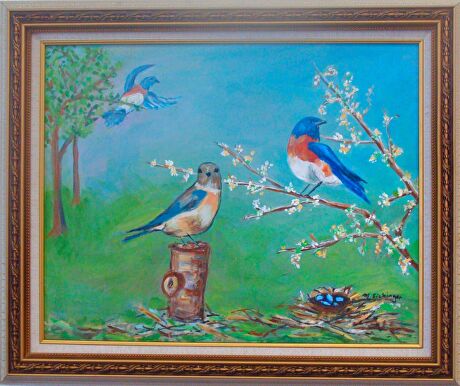
BLUE BIRDS
The smell of fresh-cut grass, bluebirds nesting in a nearby tree, and cherry blossoms floating in the wind against a bright blue sky are things that inspire awe, giving joy for the majesty of the earth.
Awe: Isn’t it awesome?
Awe is an emotion, a feeling you get in the presence of the vast unknown. Hard to describe, the feeling challenges your understanding of the universe. Awe, a mixture of fear and wonder, can fill you with respect for mystery. Eliciting an ecstasy sparked by music, art, and nature, it is experienced by infants as well as seniors on their death bed. Developmental scientists like Allison Gopnik, author of The Philosophical Baby, believe that children feel awe more often than their parents. Adults become adept at eliminating awe-inspiring experiences from their lives.
I still remember the expression on my six-month-old son’s face when seeing his first snowfall. His eyes lit up, becoming round like saucers as snowflakes fell silently around him. His mouth opened round as he reached out from my husband’s arms, trying to grasp a flake. Though many parents don’t think infants as having the capacity for awe, recent scientific investigations show the opposite. Infants are aware, thoughtful, and constantly analyzing all that they see.
I like being around young children. Their explorations allow me to relive the wonder and experience surprise, shaking me from complacency. When my three-and-a-half-year-old grandchild was upset after noticing the tires on my car were scarred with deep cuts, her observation led to an inspection of dozens of tires on cars in the lot adjacent to her apartment. Because I was there to witness the moment, I grabbed onto her curiosity and helped it evolve into something more. I learned a lot about tires that day.
Awe is mainly viewed as positive emotion, as it was the time I stood on the rim of the Grand Canyon–but that isn’t always the case. One stormy night, while driving on the New Jersey Turnpike, lightning struck a few feet in front of my windshield. It sounded like the crack of a whip, followed by a luminescent, blinding light that left me shaking in fear of its power. It wasn’t the first time I had seen lighting up close. The Franklin Institute in Philadelphia sparks lighting in a controlled environment. The demonstration was interesting, but not as awe-inspiring as it was on the turnpike.
We humans are unique in our capacity to experience awe. It awakens our minds, stirring intellectual and philosophical thoughts. We may speak of these events as being transformative, sometimes spiritual. While it may make you feel small in relation to the universe, it can also give purpose to life. Religious leaders are known to find their calling after an awe-inspiring experience.
As an expansive emotion, awe is good for our health. It takes us out of self-interest, letting us become more willing to engage with people. Awe inspires musicians, artists, philosophers, and inventors willing to share the insights gained from their mastery. They may be humbled by their achievements, but their skills can also make them strong, open-minded, and generous. And wonderment coming from admirers can inspire others to follow in their footsteps.
We would do well to put ourselves in situations that stimulate awe. Medieval cathedrals, synagogues, and mosques with stained glass windows were designed to do that for people paying homage to God. The Taj Mahal, an Ivory-white marble mausoleum in India commissioned in 1631 by Shah Jahan, was built so that visitors would feel awe at the love he had for his wife. Visits to national parks and other places of beauty stimulate wonderment for the mystery of being alive and love for the people close to us.
Hiking through natural areas, viewing a night sky that’s not dulled by city lights, hearing a virtuoso musician, and watching an olympian athlete perform are things that take us outside of ourselves. They help put our days in perspective. I challenge you this spring to seek out those precious moments that inspire feelings of awe rather than dwell in the gutter of negativity that looms incessantly on newscasts throughout the nation.
References:
Keltner. D., 2021. What is Awe? Greater Good Magazine, retrieved from Berkeley
Omary, A. 2022. The Awesome Psychology of Awe. Psychology Today. retrieved from https://www.psychologytoday.com/us/blog/natured-nurture/202207/the-awesome-psychology-awe
Art is always for sale. Bluebirds is an acrylic on canvas painting, 20.5″ by 24.5″/ available framed for $425. Shipped free within the continental U.S. Send questions to mariynne@eichngerfineart.com
Over the Peanut Fence, about homeless and runaway youth and Museum Junkies, giving a behind-the-scenes look at museums, are autobiographical and biographical accountings of unusual experiences. Books can be purchased at AMAZON
Please share a few of your awsome experiences below.
